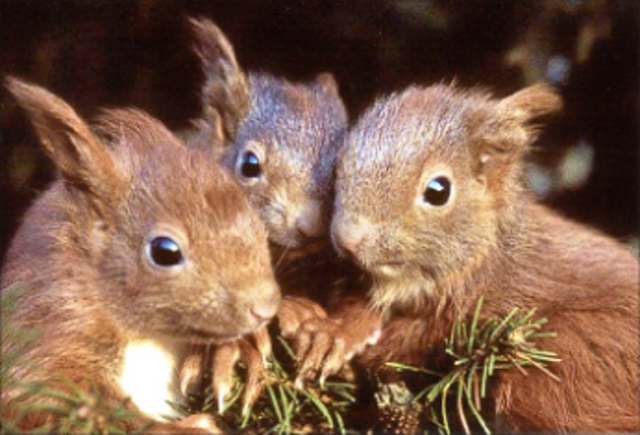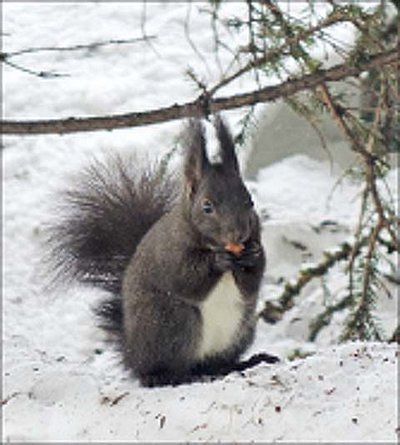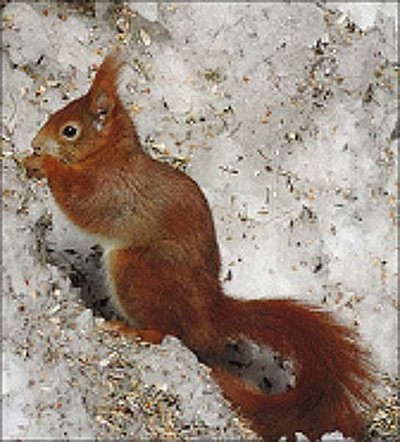Nimble climbers with bushy tail

Its popularity has fourfold reasons: quite frequent occurrence, conspicuously cute behaviour, not too much respect for humans (like the swallow, blackbird, sparrow and rat) and a daily routine that corresponds to ours so that you may also catch sight of this forest goblin more easily than species that immediately flee or even nocturnal animals.
Summer siesta yes, hibernation no
Squirrels are distinct day animals with usually two phases of activity: At dawn they become lively, at noon they have siesta, in the afternoon they are active again, and before sunset they go to sleep. In autumn their midday rest shortens and finally disappears completely so that both phases of activity merge into one which shrinks as the winter progresses and is limited to the later morning.
Contrary to popular belief, the squirrel, unlike its relative the marmot, does not hibernate. However, it strongly limits its activity in the cold season and leaves the nest only late in the morning for a short time. It only executes the unavoidable on that occasion: search for food and nature’s call. It does not back away from snow and low temperatures but it avoids stormy and rainy periods of bad weather.
Born to climb
Studies on squirrels in the open are not easy because the animals usually stay unobservable in treetops and male and female are difficult to distinguish in size, appearance, coloration and weight.
Their adaptation to life on the trees is impressive. The anatomical proportions with the supple body, the light bone structure, the very muscular hind legs and the extremely skilful forelegs with long, curved claws on toes and fingers make the squirrels real climbing artists, who rarely stay on the ground (except in parks, where, as tame animals they show atypical behaviour when begging for food).
Steering, balance and signal
We all know the squirrel in a typical calendar sheet pose: sitting upright, a hazelnut or a pine cone in the front paws and the bushy tail – like a parasol, S-shaped over the back. The ancient Greeks called this living statuette “Skiouros” (the one with his tail giving shade). This poetic paraphrase has remained in the generic name (Sciurus vulgaris) until today.
However: Proving shade is probably the most unimportant task of this powerful tail. First of all it serves as a rudder for long jumps and as a balancing pole for climbing or as an optical signal during the courtship display (love foreplay) and finally as a protection against the cold in winter. Another typical feature are the neat tufts of hair on the ears. Among the native wild animals, only the lynx has similar ear tufts.
The Reds and the Blacks
The said calendar sheet usually depicts a ginger squirrel. In reality, the colouring varies from ginger to brown to black, but always with a white underbelly. In the lowlands, the ginger variety predominates, in the hilly and regions, however, the dark. The colouring also depends on the two moults in spring and autumn.
During the transition from summer to the winter coat not only the length and density of the hairs change, but also greyish-white hairs appear more often, whereby the colouring is subdued so that ginger animals appear greyer and brownish-black animals appear lighter in colour, with silver-grey zones especially on the flanks. On the other hand, the long hair on ear tufts and tail changes only once a year after the spring hair change of the body fur.
Their home – the spherical nest
The living area of a male is about ten hectares, that of a female about half the size. At about the centre of the nest, technically speaking the drey, a slightly flattened spherical nest with an outer diameter of twenty to fifty centimetres, usually in a strong forked branch directly on the trunk and five to ten metres above the ground.
The round nest consists of a roughly weaved branches and is padded inside with grass, moss and bast. The nest cavity has a diameter of ten to twenty centimetres and is accessible through a five centimetres wide loophole. The construction of such a nest takes a few days. In addition to the main nest, an animal has usually also reserve nests, which serve as shelter for disturbances around the main drey or in search of food.
Rough wedding customs
Squirrels are considered to be non-social animals that live as a solitary animal, with little contact to fellow species. Each adult animal has its own nest, which it defends against others. This behaviour changes only in the mating season. When winter no longer has its firm grip the forest becomes the scene of the crazy squirrel wedding. First, the female chases the wooing male away then flees from him, which is leading to wild chases over several days until the female copulates in her main nest. After mating, the female again chases away the male, and both live separately again.
Pink, naked and blind
After 38 days of gestation period, younger females kittens once a year two to three kits, older females often twice a year three to five so that litters can arrive from end of February until end of August. Squirrels are born as distinct nestlings, pink, naked, blind, barely six centimetres long and weighing just under ten grams. After a few days, they begin to colour; they do not grow complete juvenile hair before two weeks and their eyes only open after about a month.
Approximately six weeks old, the tiny squirrels, now weighing over a hundred grams, leave the nest, but still drink from their mother (for about nine weeks). They also learn what is edible when fishing for food lumps from her mouth. On their excursions, they explore the tree on which they were born, the neighbouring trees and finally the entire hunting ground. Then the mother abandons the squirrel kittens to their fate. At about seven months, they are adult, and at eight to ten months, young females are already sexually mature. They usually have their first litter not until the second year.


Survival is a matter of luck
The apparently high rate of squirrel offspring is necessary because only about a quarter to a fifth of the young live to be one year old and apparently less than one percent (!) of all animals live to be five years old, while the “hereditary enemies“, pine martens and hawks, have a regulating but not a decimating effect. More serious are manmade environmental changes and the road fatalities nowadays! Being a protected animal species, the forest goblins may not hunted in Switzerland.
The optimal habitat for squirrels is a mixed forest with a tight canopy and dense shrub layer. The forests, which are segregated, poor in undergrowth and cut into plots, no longer provide a livelihood. Important is the presence of different old forest trees, because seeds (cones) grow after ten or more years and only at irregular intervals of several years. Species and age monocultures can actually become a snare for hunger.
Emergency supplies: planned coincidence
There’s hardly anything in the woods that squirrels do not make use of: Stomach tests from the midlands show that the seeds (cones) of pines and spruces are most important all year round, supplemented by beechnuts at the end of summer and enriched by buds and blossoms of coniferous wood in winter and spring. The menu also includes berries, hazelnuts, mushrooms, leaves and roots, even ant pupae, beetles, insects of all kinds, rarely even birds’ eggs or young birds.
In autumn, when the food supply is large, the squirrels diligently build up food reserves by burying them near their roots or storing them in tree hollows. Since they cannot remember all these hiding places, they search in typical places in the winter according to random principle. Sometimes they make a find, sometimes not, whereby, in passing they contribute to the seed distribution. •
(Translation Current Concerns)
Grey squirrel ante portam
HH. The American counterpart to our squirrel (Sciurus vulgaris) is the grey squirrel (Sciurus carolinensis), but it is bigger, stronger and more dominant. In addition, it is the carrier of a virus (Pox virus, “squirrel pox”) against which it is immune itself – in contrast to the native squirrel. Carelessly introduced and released grey squirrels were able to spread in the British Isles and in northern Italy and now increasingly displace the native reds.
In England, this displacement process – since the first evidence in 1876 – is already well advanced. Only in Northern England and Scotland were the reds able to survive. Throughout Great Britain, the ratio today is a good three million grey squirrels versus nearly 150,000 squirrels.
In Italy (Piedmont and Lombardy), the grey squirrel has been based since its release by private persons in the middle of the 20th century and today is represented by more than 30,000 individuals. Based on model calculations, it is assumed that the greys could occasionally reach Ticino on their way north. Following the river Ticino, the grey squirrels are only 70 kilometres away from the Swiss border. Since the Alps are not an insurmountable obstacle to their further spread, they would also have access to Central Europe, theoretically.
This changed situation attracted a European squirrel initiative, which declared war on the greys. However, because mass killings have been prevented by animal protectionists, attempts are now being made to solve the problem by means of contraception in grey squirrels, i.e. by means of immuno-contraception.
The immune system is vaccinated with antibodies that block important proteins on the surface of sperms and egg and thus prevent their fusion so that the grey squirrels are not able to reproduce any further.
However, it will be years before this method is ready for outdoor use. In the meantime, nature will solve the problem in its own way.